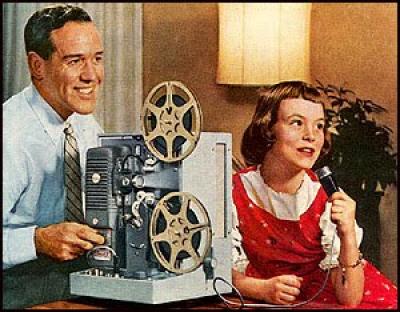Talkies
Only two of Dad’s movies have sound tracks. Not lip-sync, record-in-the-camera type sound, but sound tracks added after the film was processed and edited. To do it, Dad sent the edited films back to Kodak and had a tiny magnetic stripe applied to the edge of the film. Then, using a Kodak Sound 8 projector borrowed from work, he recorded, or “dubbed” the sound onto the movie, like this…

Actually, the girl in that picture is probably recording more projector noise than voice!
In 1963, Dad spent two weeks in Rome on a business trip. It was the trip of a lifetime (at least at that point in his lifetime!) and warranted some special film making. Dad made a wonderful 30 minute movie and added classic travelogue narration including a few examples of his dry wit…
ERROR: FLV player could not be loaded.
Transferring a sound movie like this takes a little more work. My telecine machine has no provision for sound playback, so that had to be done separately. I did a little work on Dad’s newer Eumig projector and used it to copy the sound track to an audio cassette. Then I made an MP3 from the cassette using a freeware program called Audiograbber, though there are many options for this job.
Once the sound track and the movie were in digital form by their separate and devious paths, their lengths no longer matched. I used Virtual Dub to change the frame rate of the movie to 30 fps (by duplicating frames in a regular pattern), then modified the length of the sound track in the Audacity audio editor, using it’s “Change tempo” feature. I also applied a band pass filter (Equalization) to cut the hum and hiss from the recording.
With the AVI movie and the MP3 audio now the same length, I merged them in Virtual Dub and checked the sync. Some of the bits of narration were a few seconds early or late, so I used Audacity to shift them to the right place. Fortunately, Dad left long pauses in his narration, so it was easy to correct the timing by cutting the needed seconds of dead space and pasting it on the other side of the sound bite. I could imagine the patience it took him 45 years ago to get the timing right as he watched the film and read into the mic from his script.
The Rome movie was always one of our favorites, and the digital version is even better.
Some more samples…
ERROR: FLV player could not be loaded.
ERROR: FLV player could not be loaded.
ERROR: FLV player could not be loaded.
